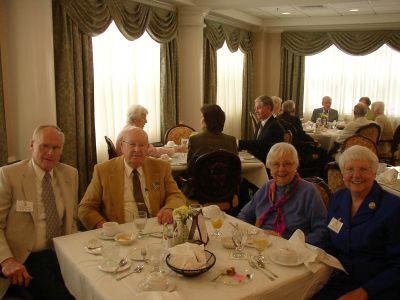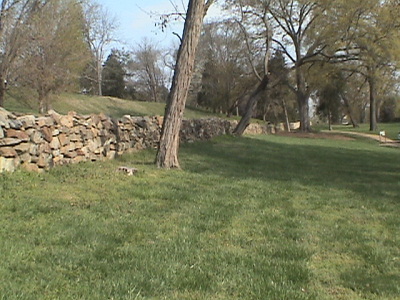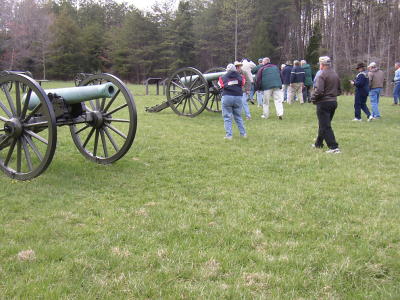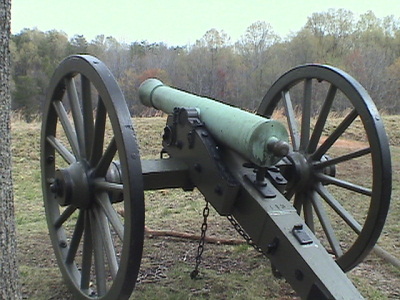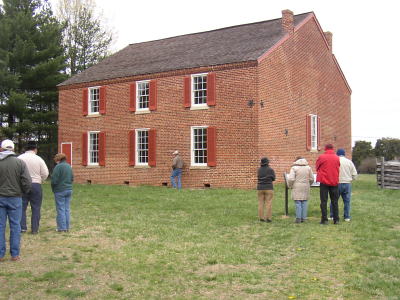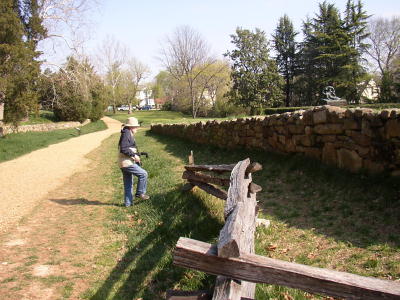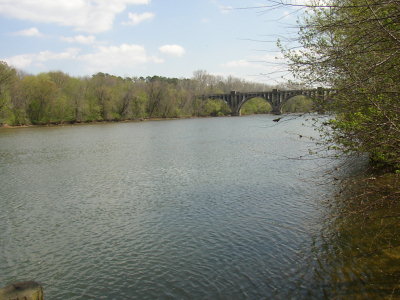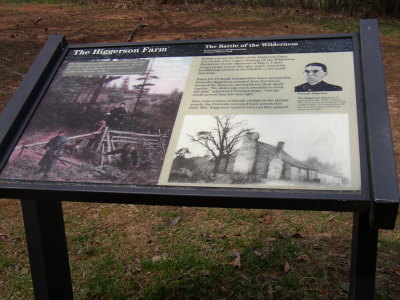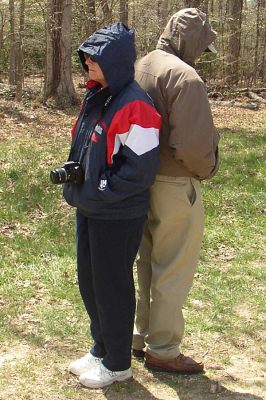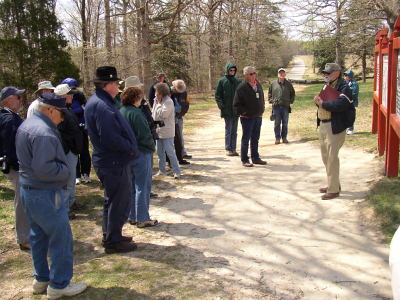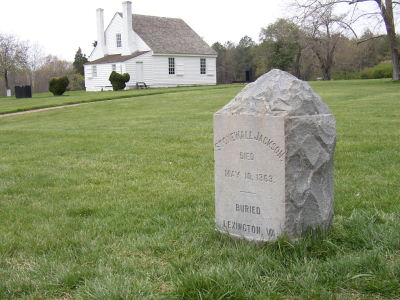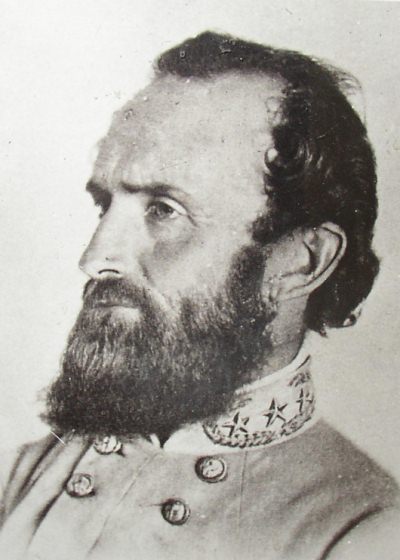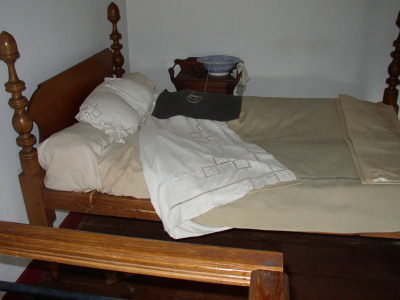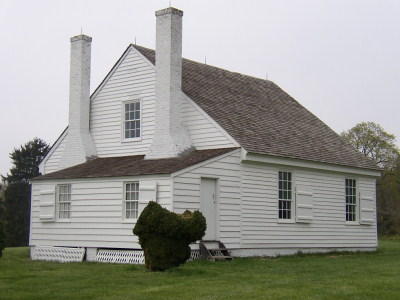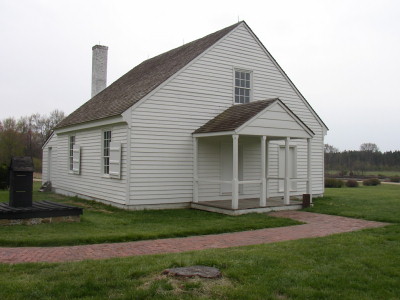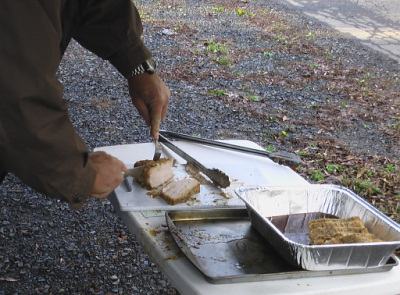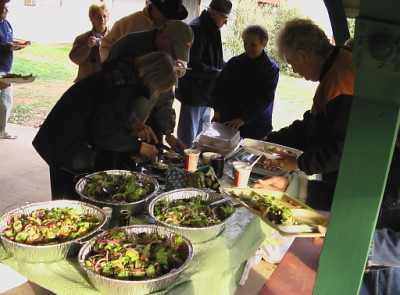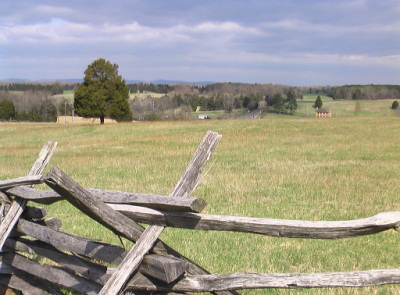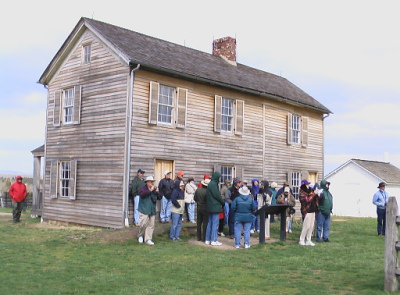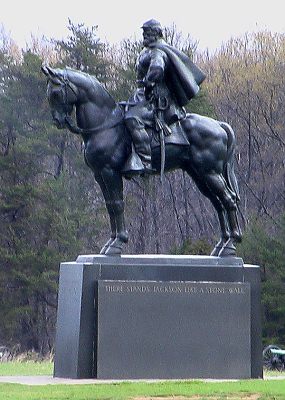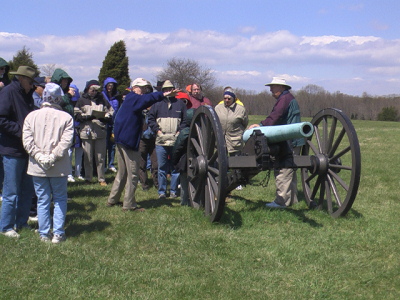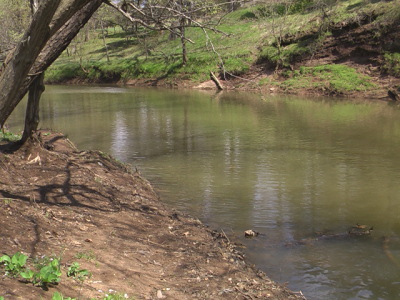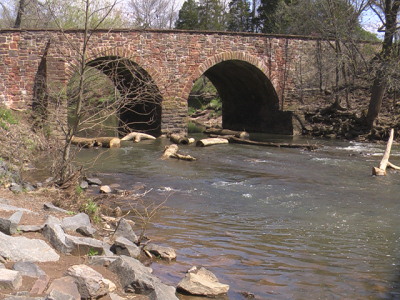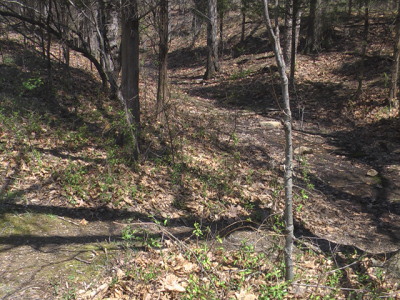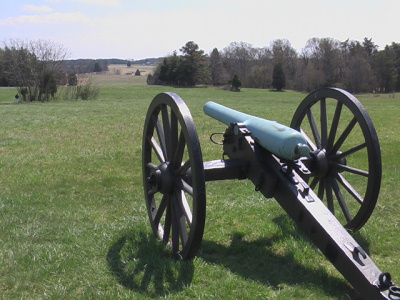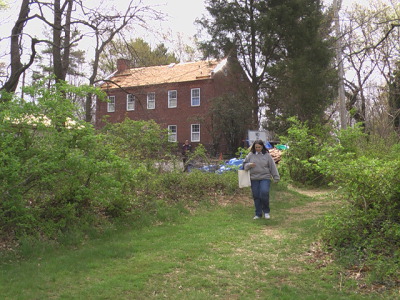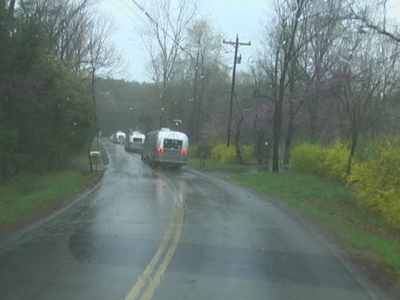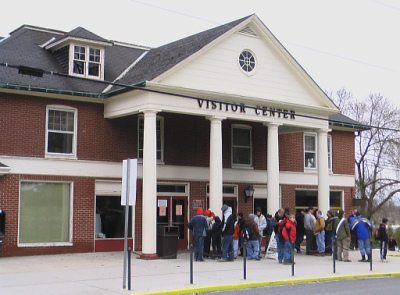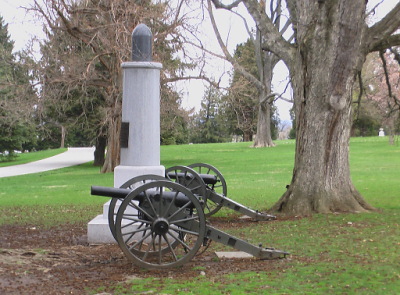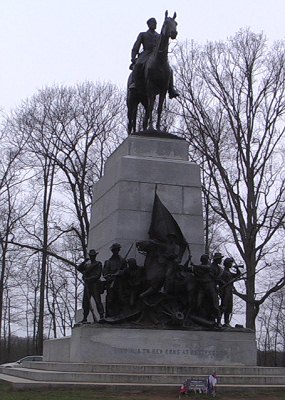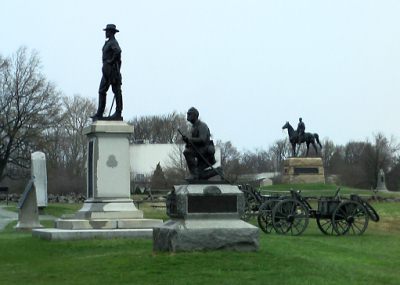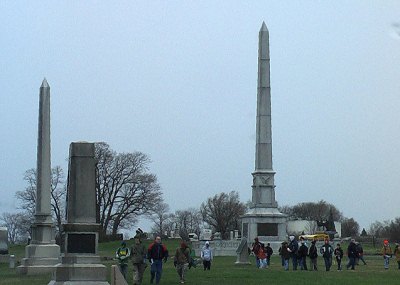Sunday, April 8, 2007 - This was moving day - to Fredericksburg, Virginia. We left the Pocahantas campground early to join Mary Love and Dave Schumaker at their church in Mechanicsville - the Fairfield Presbyterian Church. After a delightful lunch with them at Covenant Woods, we continued on to our campsite - the Fredericksburg KOA.
After settling in in Fredericksburg, we had an hors d’oeuvre and egg hunt party in the campground recreation room. It was loud and competitive, and there was plenty of things to eat - shrimp, meat balls, crab, pickled asparagus, cheese, crackers, and several kinds of dip,
Monday - April 9, 2007 - We ratcheted time back to 1862 and 1863 today, visiting the Fredericksburg Battlefield first. On December 13, 1862 the Confederates were holding the high ground west of Fredericksburg behind a rock wall and sunken road, It was the Confederate's most lopsided victory of the war. The Federals lost 12,353 men to the Confederate's 4,576, When it was over, the sunken road was filled with bodies. The sunken road is now filled in, but it was easy to visualize the carnage. Adjacent to the National Military Park is a national cemetery with 15,300 Federal graves - dead soldiers brought in from many other campaigns.
Our historian guide - Frank, a retired attorney - led us through the battlefields around Fredericksburg, explaining in great detail why this was such a strategic battle site. Its location midway between the combatant capitals placed it right in the path of the Union army attempting to reach Richmond.
Five months later, there were significant battles all around Fredericksburg. While the Confederates under Lee and Jackson prevailed at the end, it was at a horrific cost in lives. Battles at Prospect Hill, Chancellorsville, Spotsylvania, and the Wilderness are well documented, and the battlefields are well preserved. Not only did the Confederacy lose thousands of men, but key generals like Stonewall Jackson were lost.
We carpooled to Prospect Hill with our guide talking on the CB. Our next stop was at the Old Salem Church. This old church was used as a command headquarters and hospital.
Then, it was lunchtime with box lunches most of us ate in the car to get away from the cold weather for a few minutes. We then toured some of the battle sites near Chancellorsville, getting back to the campground in time for our third GAM as we gathered in the rec room again.
Tuesday, April 10, 2007 - We began the day with a carpool trip to the Chancellorsville Museum and Visitor Center where we saw a good movie which brought a lot of what we've seen into perspective. Most battles have been named for a nearby town or nearby river. The Chancellorsville battle was named for the private home and tavern of the Chancellor family whose home just happened to be where the battle took place in early May of 1863.
The Wilderness Battle took place on May 5th and 6th - a year after Lee's defeat at Gettysburg - then moved on to Spotsylvania Court House. As the armies moved to WidowTapp's field, then Bloody Angle, thousands died with no clear winner. Ulysses S. Grant was now the commander of the Union troops. These were the first of the classic engagements between Grant and Robert E. Lee. The battle raged in confusion with one side then the other pushing forward. It ended in essentially a stalemate, although it further weakened the Confederates. That was the case of every succeeding battle. The Union could replace their lost men while the Confederacy could not. We met our tour guide - Frank Walker - at the Wilderness site and while stopping at several locations, he recited details of the battles.
By the time it was over, everyone was ready to retreat from the cold. Yet, that very cold weather made the misery of the soldiers come more alive. After Bloody Angle we were free to spend the rest of the day on our own. We drove into Fredericksburg to get a look at the historic downtown area and the Rappahannock River. Fighting never actually touched the city, so many antebellum homes were there - some remarkable mansions. Most of the old town is practically on the banks of the Rappahannock. Ocean going vessels once visited Fredericksburg, but as the river silted up and ships grew in size to require more depth, that activity ceased. The Union pontoon bridges that were built and finally allowed the troops to cross were located further to the west at narrower spots.
Wednesday, April 11, 2007 - This was a free day for the caravanners. Some chose to explore the area on their own; some chose to drive up to George Washington's home - Mount Vernon; and some just stayed put and relaxed or did laundry.
About four miles from our campground along the Guinea Station Road is the Stonewall Jackson Shrine – the little house where he died. It was to the Fairfield Plantation, the home of the Chandler family, that Jackson was brought on May 4, 1863. The ambulance was a horsedrawn covered wagon. It was a grueling 14 hour ride along primitive roads. Guinea Station was the nearest place where he could be put on a train to Richmond, but no trains were running. His left arm had been amputated and his right hand bandaged – injuries he received when shot by friendly fire in the confusion at Chancellorsville. He lived for six days after arriving at Fairfield, succumbing to pneumonia on May 10, 1863. There’s some evidence that he had the pneumonia before he was injured, and may have fallen victim to that whether or not wounded, but that is conjecture. His body was taken from here to Richmond where 25,000 mourners paid their respects. From there, he was taken to Lexington for burial near Virginia Military Institute where he had taught for ten years prior to the war.
Thursday, April 12, 2007 - Today was moving day - from Fredericksburg to Manassas. After a 9:30am drivers meeting to be certain that everyone was on the same page, the leaders and parking team began the 65 mile trip. An hour later most of the caravan was on the road, with strict instructions not to arrive in the new campground before 1:00pm. As we arrived in the Bull Run Regional Park Family Campground, the parkers advised us of our assigned spots. The weather was considerably warmer, but rain was intermittent with a few hail showers.
At 6:15pm the Skippers - Jim and Sheila - had prepared a fantastic cookout meal of grilled pork loins, enhanced by a super Greek salad prepared by the Johnsons - John and Maryann. We gathered under a park picnic shelter to enjoy the meal. The evenings GAMs were combined with the meal, each GAM group sitting together to get better acquainted. These caravan cookouts bring us together as nothing else could.
The young man in the picture to the right is our caravan sheriff. He’s nine year old Nathan Reinertsen. He’s the grandson of Raoul and Anita Reinertsen, spending a month with them on this caravan. As sheriff, his duty is to make sure that all caravanners wear their identification badges at all time. If he catches someone not wearing a badge, the fine is 25 cents, collectable on the spot. Nathan has been very diplomatic in carrying out his duty, yet has collected quite a fund. He’s a bright, delightful young man, not in the least daunted by all the old folks around him. I think he plans to use the money for an ice cream party near the caravan’s end.
Friday, April 13, 2007 - We carpooled to the Battle of Manassas Visitor Center early to first watch a movie, then to do a walking tour with a Park Ranger. The movie was entitled "The Loss Of Innocence," the story of the first battle of Manassas - the first land battle of the Civil War. As the armies marched toward each other on the 16th of July, 1861, both sides thought that there would be one battle and the war would be over. Civilians came down from Washington to picnic and watch the battle as an afternoon's entertainment. After receiving a sound drubbing by the Confederates, the panicy remains of the Union troops retreated in embarrassment, and the horrors of war became a reality as the shock set in. There were 5,000 casualties - the bloodiest day in American history to that point. Nothing would ever be the same again.
There was a cold wind blowing as we began the walking tour of the Manassas Battlefield. The battle was called the First Battle of Bull Run by the Union, and we were walking over the very ground where the fighting took place. A park ranger interpreted as we passed the Henry House where an 85 year old lady - Mrs, Judith Henry - was killed as she lay ill in her home when an exploding cannonball hit the house, She was the only civilian to die in the fighting. Behind the Henry House, a monument shaped like a sharp pyramid stands to the "Patriots who fell at Bull Run."
We passed the spot where Tom Jackson and his brigade were first called Stonewall as they refused to budge in the fighting. A life size statue of Jackson on his horse, Little Sorrel, tops the monument.
Then after a picnic lunch (eaten in our cars because of the cold) we loaded up and took a car tour around other significant sites on the battlefield. We passed Stone House, an old tavern that served as a field hospital during both First and Second Manassas. We climbed to the top of Matthews Hill where Union artillery stood, then descended to the Stone Bridge that spanned Bull Run creek. Crossing that creek was more difficult than it looked to the Union troops. The delays incurred cost them the element of surprise in the battle that followed.
We then visited two sites along an unfinished railroad bed, important because it provided an excellent defensive position for the Confederates in the Second Battle of Manassas that occurred 13 months after the first. All along this car tour, a park service volunteer gave us a running commentary, explaining the details of the battles.
The First Battle of Manassas was a clear victory for the Confederates. The Second Battle of Manassas was called a Confederate victory because they drove the Union troops out of Virginia, but they failed to destroy the Union army, a result they had hoped for, so it wasn't a complete victory. It did clear the way for the Confederates under Lee and Jackson to invade the north for the first time. Battles at Sharpsburg, Maryland and Gettysburg, Pennsylvania ensued.
Saturday, April 14, 2007 - We visited the old Liberia plantation home on this day. Built in 1824, this home was used by the Confederates as General Beauregard’s headquarters in 1861 during the First Battle of Manassas. As control of the area shifted back and forth, the old house was used by both Confederate and Union, depending on who was in control at the time. It was visited by both Presidents, Davis and Lincoln. The City of Manassas has just recently been given title to the property and is restoring it to its 1861 state - a five year project. It is not yet open to the public for touring, but we were given a special tour on this Saturday morning by the City’s historian.
Following the Liberia tour, we met at the Manassas Museum downtown for a short film and tour. Then it was time for lunch shared with John and Judy Hice in the historic town. Manassas didn’t exist as a town prior to the Civil War, so there are no ante-bellum homes or buildings, but it is surely a thriving place now with heavy traffic and lots of shopping malls.
Everyone was sad to see Peter and Loree Ferguson leave the caravan due to a family crisis.
Sunday, April 15, 2007 - Today we moved to Gettysburg, Pennsylvania for a four night stay. It rained the entire 86 miles, and we heard that the campground we left in Manassas had closed down shortly after our departure because of flooding. The weather news was not good, but we made it fine. A cookout scheduled for this afternoon had to be cancelled, so there were no caravan activities for the rest of the day.
Gettysburg - the turning point of the war, where Robert E. Lee suffered his first and worst defeat; where there were over 50,000 casualties on both sides in three days of fighting, and when it was over 5,000 horses and mules lay dead on the battlefield. July 1st, 2nd, and 3rd, 1863. Later that year Abraham Lincoln rode the train in from Washington and delivered his most famous speech - the Gettysburg Address:
 "... that these men shall not have died in vain that this nation, under God, shall have a new birth of freedom - and that government of the people, by the people, for the people shall not perish from the earth."
"... that these men shall not have died in vain that this nation, under God, shall have a new birth of freedom - and that government of the people, by the people, for the people shall not perish from the earth."
Monday, April 16, 2007 - The wind blew through the trees in a roar all night, and by morning it was cold and still blustery. We carpooled in to the Gettysburg Visitors Center for a confusing showing of the electric battlefield exhibit. Somehow the narration was not in sync with the lights. We learned later that a mistake had been made by somebody. If the armies were as confused as that demonstration, it is no wonder that it was a disaster. The guided auto tour around the battlefield was much better, although the cold wind made it miserable to get out at the stops. We rode with Dave and Cathy Carlig. Our guide kept up a refreshing narration via CB radio, describing some of the details of the battles as we drove along in a string of cars behind him.
As the armies circled around the battlesite sizing each other up, there was an irony to their approach to each other. The Confederates were north of the city marching southward, while the Federals were south of the city marching northward. The Federals were the first to occupy the high points, which proved to be decisive. The Confederates were always trying to climb up a hill in the face of the enemy's artillery.
There are more monuments in the Gettysburg National Military Park than in any other place in the country - over 1500. Most of them were placed during the 1870s, just a few years after the battles. Most were placed by the survivors of each fighting unit. Some of the sculptures are elaborate to the extreme; others are simply engraved stone, probably reflecting the available funds in each case.
Lots of changes are taking place in the park. A new state-of-the-art museum and visitors center is under construction which promises to enrich a visitor's experience. All of the existing museum and visitors center buildings will be torn down. The Cyclorama painting is being restored and enhanced, The Park Service is buying up homes and businesses within the area with plans to restore those that date back to the battle or tear others down so as to restore the landscape to its 1863 condition. Power lines are being placed underground because none were in existence in 1863. Even trees that have grown up since the battles are being removed. Most of the funding for this $95 million project is coming from a private foundation. The completion of all that will provide incentive for a return trip.
We were free during the afternoon to meander on our own, but it didn't take long for most to return to camp because of the cold. The weathermen were forecasting the possibility of snow. Something has happened to Spring.

